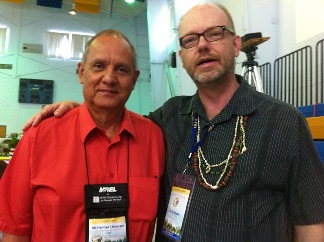WIDA Researchers Bring Language Testing Ideas to South Korea and Saipan
September 9, 2013

WIDA Executive Director Tim Boals with CNMI School Board President Herman Guerrero
Creating tests for students is a tricky business under any circumstances. When the students taking the test aren’t native speakers of the language the test is in, the task gets quite a bit more complicated.
The World-Class Instructional Design and Assessment (WIDA) project specializes in test research and design for linguistically diverse students. While most of WIDA’s work has been focused inside the United States, in July, four WIDA researchers traveled to South Korea to get an update on the latest research and exchange ideas with the foremost language assessment experts in the world.
The 35th Annual Language Testing Research Colloquium took place from July 1 to 5 in Seoul, attracting more than 500 scholars and professional test developers from universities and nonprofits based in dozens of countries spanning five continents.
[Tim Boals and Herman Guerrero]
WIDA Executive Director Tim Boals with Commonwealth of the Northern Mariana Islands School Board President Herman Guerrero at the Pacific Educational Conference in Saipan
“This was a very interesting and important conference for us to attend because there’s a big shift in thought occurring in the international testing community,” said Tim Boals, WIDA’s executive director, who attended the conference along with lead developer Margo Gottlieb; Carsten Wilmes, WIDA’s director of assessment; and WIDA partner Dorry Kenyon, who is also vice-president at the Center for Applied Linguistics (CAL).
“Nowadays internationally, the move is towards a more communicative approach to language learning,” Boals said. “Before, conversation wasn’t a main goal of language tests – it used to be about grammar and how to create a translation of a written passage. Now many countries are moving towards including a higher level of communicative proficiency. The next step that is beginning to happen is a shift towards communication within specific content areas, like learning English within a science class.”
On the last day of the conference, the WIDA group presented on the topic of “Broadening language assessment horizons: From large-scale accountability to diagnostic purposes.” The talk focused on WIDA’s work contextualizing the language of its assessments, specifically in core content area classrooms like math and science.
Boals estimated the size of the audience attending the WIDA talk at between 75 to 100 people. Amongst the crowd were a number of international educators eager to learn how to better prepare their students planning to attend college in the U.S.
“A lot of international attention is being placed on grooming students who at 18 or 19 are going to come to the U.S. and walk into a Math 101 class that’s taught in English,” Boals said. “It’s a huge topic of interest as countries try to bolster their language programs to allow more of their students to study internationally.”
After the conference, Boals continued on to Saipan, the main island of the Commonwealth of the Northern Mariana Islands, a newly minted member of the WIDA Consortium. As a U.S. commonwealth, the Northern Mariana Islands Public School System was able to join the current tally of 33 U.S. state educational agencies organized by WIDA to collectively study the design and implementation of assessments for English language learners, including WIDA’s ACCESS for ELLs assessment.
Boals’ arrival coincided with the Pacific Educational Conference (PREL), a biannual conference that brings together educators from many Pacific Islands, including Saipan and its sister island, Guam; American Samoa; Hawaii; the Federated States of Micronesia; the Republic of the Marshall Islands; and the Republic of Palau.
“It was very interesting for me to observe, as this is the only time in two years that these educators get to see each other,” Boals said. “It’s like a big homecoming for all of them to get together and share strategies regarding what’s working in their classrooms.”
The educators at the conference face no easy task; the language and cultural backgrounds of their students are extremely varied. On the island of Saipan alone, Chinese, English, Chamorro, and Philippine languages are all commonly spoken.
“The folks I met have a great understanding of multiple languages and cultures, because all of these islands are so linguistically and culturally diverse,” Boals said. “The daily instruction is happening in many different languages on some islands. The agreement at the conference was that the overall goal is to build on students’ native languages and also help them become proficient in English. There was consensus that the global language of the 21st century is English, and in order for students to be able to leave their islands to get a rich college experience, they’re going to need a high level of English literacy.”
The main reason for Boals’ visit was to provide a keynote address on the importance of language learning and literacy development within every classroom in every school. But, after hearing from educators at the conference, a bonus was that Boals came away with a clearer picture of improvements necessary to make the MODEL K-12, WIDA’s assessment in use internationally, work more effectively for Asian schools.
“It turns out (they) have different needs for their assessment – there’s a need for more items at the upper and lower ends of the assessment’s continuum, because it turns out a lot of kids in the American private schools are really, really proficient in English, and many of the students in public systems abroad are just beginning to move towards communicative methodologies for teaching English,” Boals said.
Boals returned from his trip with a newfound respect for the passion and knowledge level of the international educators he came across during his travels.
“They’re working hard to put themselves right on the edge where the latest research is interacting with practice,” he said. “In talking with them, it became clear their hard work all comes from the passion they have for their kids, and how badly they want to see them succeed.”


